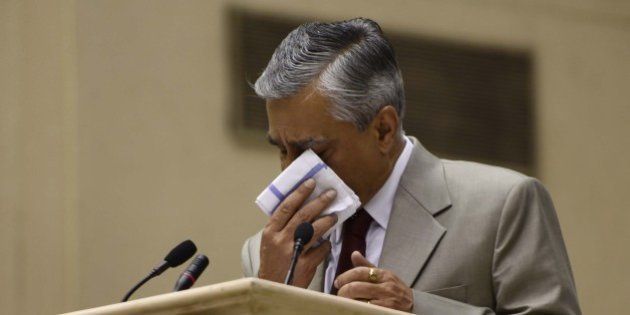
NEW DELHI -- Over the weekend, Chief Justice of India Tirath Singh Thakur implored Prime Minister Narendra Modi to double the number of judges serving in Indian courts.
Speaking at a conference of chief justices and chief ministers on Sunday, Thakur made an emotional appeal to the central government to provide some respite to the serving 21,000 judges, who are handling a preposterous number of cases, while tens of thousands of people languish in jail without having been proven guilty.
Thakur is not the first chief of the Indian judiciary to sound the alarm over just how the bad the situation is for judges and inmates in the country, but it was his choked voice and coming close to tears, which made us pause to listen.
Rubbing his eyes with his handkerchief, Thakur told Modi, "I beseech you to rise to the occasion and realize that it is not enough to criticize. You cannot shift the entire burden on the judiciary."
Here are some shocking figures which will make you want to cry over the state of the Indian judiciary, and our treatment of accused men and women, whether they are proved guilty or not.
1) Over three crore cases are pending in Indian courts. In 2009, then Prime Minister Manmohan Singh said that India had the world's largest backlog of court cases.
In 2010, Andhra Pradesh High Court's Justice V.V. Rao said that it will take 320 years to clear the backlog.
2) As of December 2014, 64,919 are pending in the Supreme Court. At the end of 2013, there were 44.5 lakhs cases pending in High Courts and 2.6 crore cases pending in district courts.
Bloomberg Businessweek estimates if that all the judges attacked their backlog without breaks for eating and sleeping, and closed 100 cases every hour, it would take more than 35 years to catch up.
3) With 10,43,398 pending cases, Allahabad High Court, which serves the India's most populous state of Uttar Pradesh, has the worst record.
4) As of December, 2014, Delhi High Court has 64,652 cases pending before it.
In 2009, former Chief Justice of the Delhi High Court A.P. Shah, who retired in 2010, said that it would take the court approximately 466 years to clear the pending 2,300 criminal appeals cases alone.
5) The current rate of disposal suggests that it could take 10 years for district courts to clear the backlog. In the district courts of at least six states, more cases are being filed than disposed off every month, which means that the pending cases will never be cleared.
6) Justice Markandey Katju, a retired Supreme Court judge, has said that judges should not have more than 300 cases pending at any one time, but judges in India have 15,000 to 30,000 pending cases.
7) At the end of 2014, there were 2.82 lakh under trial prisoners languishing in jails. Almost 68 percent of all inmates in the country's 1,387 jails are under-trials, and many of them are too poor to raise bail.
In September 2014, the Supreme Court directed release of under-trial prisoners who had completed at least half their maximum prison term.
8) In 2009, Commonwealth Human Rights Initiative reported that the average time spent by an under-trial in jail from the time he is brought into prison and can leave – whether through plea bargaining or on bail – is 266 days or just under nine months in prison.
CHRI reported that the average was up by thirty-two days or just over a month from 224 days or seven months in 2005.
9) In 1987, 7,675 judges served in the Indian judiciary, which worked out to 10 judges for every million people. The Law Commission then had recommended an increase in the number of judges to 40,000 to provide 50 judges for a million people. At the time, the corresponding figures in the United States, United Kingdom, Canada and Australia were 107, 51, 75 and 42 respectively.
In 2016, India's judge-population ratio of 17 judges per million is among the lowest in the world. On an average, developing nations have 35-40 judges for a million citizens, while developed countries have 50.
10) As of April 2016, there are 4,600 vacancies in the subordinate judiciary, which is more than 23 percent of the strength, and 462 vacancies in the in the High Court, which is 44 percent of the strength.
11) As of 2013, only 5.8 percent of the total number of judges in India’s 24 courts are women.
12) While some cases have been pending for decades, BBC reported on one trial which has lasted for over a century. The Doshipura court case, which started in 1878, is a dispute between Shia Muslims and Sunnis over two acres of land in Varanasi.



Contact HuffPost India
Also on HuffPost India:
